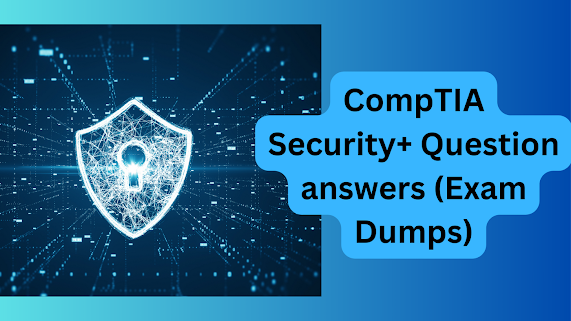CompTIA Security+ Exam Dumps
Here are 25 authentic and legitimate sample questions and answers for the CompTIA Security+ certification exam:
1.What is the primary function of a firewall?
Answer: The primary function of a firewall is to block unauthorized access to a network while allowing authorized traffic to pass through.
2.What is a common vulnerability associated with WEP wireless encryption?
Answer: A common vulnerability associated with WEP wireless encryption is that it uses a weak initialization vector, which can be exploited to reveal the key.
3.What is the purpose of a digital signature?
Answer: The purpose of a digital signature is to verify the authenticity and integrity of a digital document.
4.What is the difference between symmetric and asymmetric encryption?
Answer: Symmetric encryption uses the same key for both encryption and decryption, while asymmetric encryption uses a public key for encryption and a private key for decryption.
5.What is the purpose of an intrusion detection system?
Answer: The purpose of an intrusion detection system is to monitor network traffic for signs of unauthorized access or malicious activity.
6.What is the difference between a vulnerability and an exploit?
Answer: A vulnerability is a weakness in a system or application that could be exploited, while an exploit is a specific attack that takes advantage of a vulnerability.
7.What is the purpose of a virtual private network (VPN)?
Answer: The purpose of a virtual private network is to create a secure, encrypted connection between two devices over the internet.
8.What is the difference between a virus and a worm?
Answer: A virus is a type of malware that spreads by infecting other files or programs, while a worm is a self-replicating program that spreads through a network or the internet.
9.What is the principle of least privilege?
Answer: The principle of least privilege is the concept of granting users or processes only the minimum access necessary to perform their tasks.
10.What is the purpose of a security policy?
Answer: The purpose of a security policy is to provide guidance and direction for security practices within an organization.
11.What is the difference between a denial-of-service (DoS) attack and a distributed denial-of-service (DDoS) attack?
Answer: A DoS attack is an attack in which a single device or network is targeted with a flood of traffic or requests, while a DDoS attack is an attack in which multiple devices or networks are coordinated to target a single device or network.
12.What is the purpose of a risk assessment?
Answer: The purpose of a risk assessment is to identify potential security risks and vulnerabilities within an organization.
13.What is the difference between confidentiality, integrity, and availability (CIA) in information security?
Answer: Confidentiality refers to protecting information from unauthorized disclosure, integrity refers to protecting information from unauthorized modification, and availability refers to ensuring that information is accessible when needed.
14.What is the purpose of a honeypot?
Answer: The purpose of a honeypot is to lure attackers into a controlled environment where their activities can be monitored and analyzed.
15.What is the difference between a vulnerability scan and a penetration test?
Answer: A vulnerability scan is an automated scan that identifies potential vulnerabilities in a system or network, while a penetration test is a simulated attack that attempts to exploit vulnerabilities to determine the level of security of a system or network.
16.What is the purpose of an access control list (ACL)?
Answer: The purpose of an access control list is to define what users or devices have access to specific resources or areas of a network.
17.What is the purpose of encryption in information security?
Answer: The purpose of encryption is to protect the confidentiality of information by scrambling it so that it cannot be read by unauthorized parties.
18.What is the difference between authentication and authorization?
Answer: Authentication is the process of verifying the identity of a user or device, while authorization is the process of granting access to specific resources or areas of a network based on the authenticated identity.
19.What is the purpose of a security incident response plan?
Answer: The purpose of a security incident response plan is to provide a systematic approach to detecting, containing, and resolving security incidents.
20.What is the difference between a vulnerability assessment and a risk assessment?
Answer: A vulnerability assessment is a process of identifying potential vulnerabilities in a system or network, while a risk assessment is a process of identifying and prioritizing potential security risks.
21.What is the purpose of a security baseline?
Answer: The purpose of a security baseline is to establish a minimum set of security standards and requirements for a system or network.
22.What is the difference between physical security and logical security?
Answer: Physical security refers to the measures taken to protect the physical assets of an organization, while logical security refers to the measures taken to protect the digital assets of an organization.
23.What is the purpose of a security audit?
Answer: The purpose of a security audit is to evaluate the effectiveness of an organization's security controls and policies.
24. What is the difference between a firewall and an intrusion prevention system (IPS)?
Answer: A firewall is a network security device that filters traffic based on predefined rules, while an IPS is a network security device that actively monitors network traffic for signs of malicious activity and can take action to block or prevent it.
--------------------------------------------------------------------------------------------------------
Find more IT materials AND courses on https://itexamtools.com
=======================================================================================================================
=======================================================================================================================













































































![[NEW] CompTIA A+ (220-1101) Test Prep, Exams and Simulations ( Udemy sale, Buy Now! )](https://img-c.udemycdn.com/course/480x270/4656032_7284.jpg)






















Comments
Post a Comment